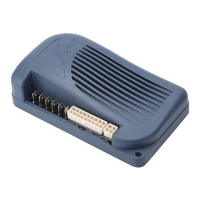Curtis 1228 Manual, Rev. F
37
6-l. Return to fast speed operation, and this time throw the throttle into >80%
reverse. Now you are experiencing the deceleration behavior determined by
the E STOP rate.
6-m. Adjust the E STOP value to produce the desirable “feel” for emergency stops:
typically as fast as possible without making the vehicle unstable.
6-n. Note that the E STOP rate should always be faster than (or equal to) the
fastest forward deceleration rate,
DECEL MAX SPD.
7 Adjusting load compensation
The
IR COMP COEFF parameter is used to set the percentage of the maximum motor
resistance that will be applied, i.e., (
IR COMP COEFF) × (MOTOR R), to compensate
for increased load caused by uneven terrain.
The trade-off in setting this parameter is that as ability to overcome load
disturbances increases, operating smoothness decreases. A high IR COMP COEFF
value will allow the vehicle to continue creeping at a low speed, even though it
has just contacted a bump in the threshold of a doorway. But if
IR COMP COEFF
is set
too high, it may make the vehicle “jumpy” during normal driving. Small
throttle movements in this case may no longer provide gentle linear accelera
-
tion, but instead initiate accelerations with a sharp jerk. Therefore, the tuning
goal is a balance between adequate load disturbance response and normal ac
-
celeration/deceleration response.
The normal range for
IR COMP COEFF is approximately 50–80%. Larger
numbers provide stiffer, stronger response. If the value needs to be much larger
or smaller than this range to achieve acceptable performance, the
MOTOR R has
probably not been set up correctly and should be checked. Note: Largely dif
-
ferent settings for IR COMP COEFF will affect the maximum speeds that were set
in Step 5. Therefore, if you make large changes to
IR COMP COEFF, you should
repeat Step 5.
Assuming that
MOTOR R is set correctly (within 10–20%), some general
rules of thumb apply:
7-a. If the vehicle rolls the other direction near the end of a stop on flat ground,
IR COMP COEFF is set too high.
7-b. If the vehicle seems to decelerate to a stop in a nonlinear fashion, IR COMP CO-
EFF could be set too high.
7-c. If the vehicle is extremely “jumpy” (i.e., responds abruptly to small throttle
changes, IR COMP COEFF could be set too high.
7-d. If the vehicle is still moving on a modest ramp when the brake gets set,
IR COMP COEFF is set too low.
7-e. If the vehicle speed varies dramatically when cresting a hill, IR COMP COEFF
is most likely set too low.
5 — VEHICLE PERFORMANCE ADJUSTMENT

